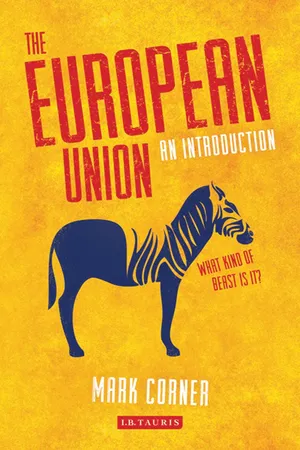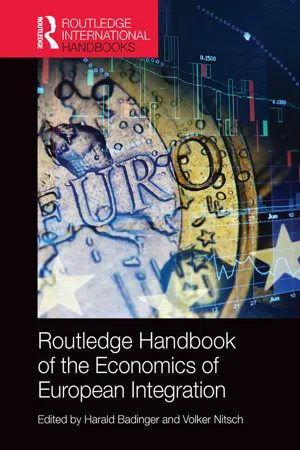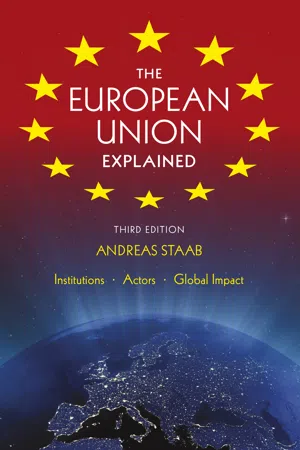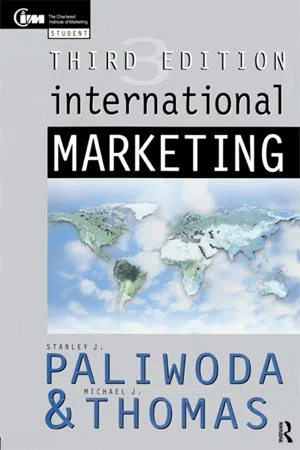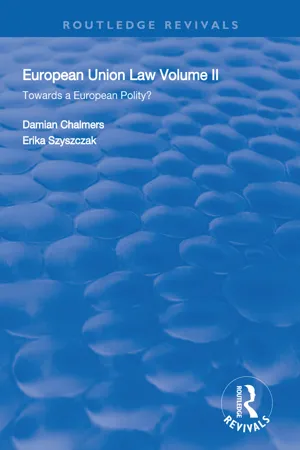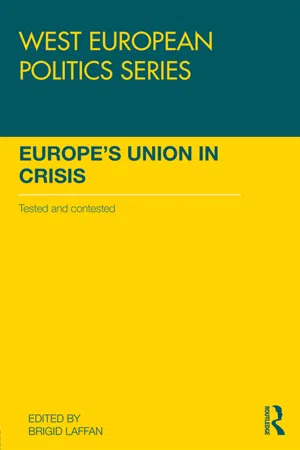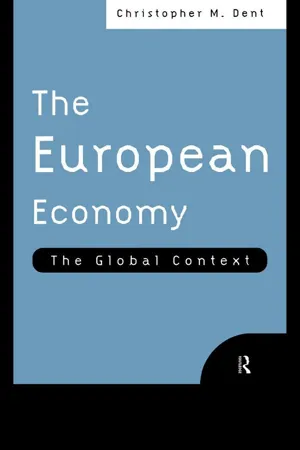Economics
European Single Market
The European Single Market refers to the free movement of goods, services, capital, and people within the European Union (EU). It aims to create a unified economic area without internal borders, allowing for the seamless flow of trade and investment. The single market promotes competition, innovation, and economic growth by providing a level playing field for businesses and consumers across the EU.
Written by Perlego with AI-assistance
Related key terms
9 Key excerpts on "European Single Market"
- eBook - ePub
The History of European Integration
A new perspective
- Ivan T. Berend(Author)
- 2016(Publication Date)
- Routledge(Publisher)
As an alternative it recommended “setting the stage for a new type of association” with governance by uniform legislation, which would ease joint activities by enterprises from different Member States, permit cross-border mergers, and generally “create an environment or conditions likely to favour the development of cooperation between undertakings.” 5 With this document, the European Commission, in the summer of 1985, provided a plan for what European big business had been requesting for at least a decade: policies that would allow them to “redefine their ‘home’ market as the European as opposed to national market.” 6 Nine countries accepted the Single European Act in February 1986, but—because of some difficulties of ratification in Denmark and Ireland—the act only came into force in July 1987. After two decades of stagnation in the integration process, Delors had brought about the first ambitious revision of the Treaty of Rome; the European Single Market had finally become a reality. 7 Figure 5.1 Intra-European trade as a percentage of world trade 2006 Source: Based on statistics from OECD Factbook 2006 (Paris: OECD, 2006). A press release from the EU describes the Single Market as follows: “… the common area … where goods, services, capital and persons can circulate freely.” It goes on to state that “the Single Market also ensures that European citizens are free to live, work, study and do business where they want in the EU …”. 8 But the Single Market has brought even more. With barriers removed and national markets opened, more firms now compete against each other. This means lower prices—and wider choice—for the consumer. Figures for 2006 show that firms selling on the Single Market had unrestricted access to nearly 500 million consumers in the EU (see Figure 5.1) - eBook - ePub
The European Union
An Introduction
- Mark Corner(Author)
- 2014(Publication Date)
- I.B. Tauris(Publisher)
Fukuyama’s characterisation of the EU in this manner (followed up by a range of other clichéd analyses of the ‘Americans are from Mars, Europeans are from Venus’ variety) not only fails to recognise the important ways in which the EU is developing in more ‘Martian’ areas (see Chapter 7) but fails to see just how much is involved even on the strictly Venusian side of things. The single market may be an economic issue, but creating one is a highly politically charged activity. After all, the ‘economic’ issues are those that in almost all cases (in European but also, it may be said, in US elections) matter most to voters. That national leaders, responsive and accountable to their national electorates, have nevertheless gone a long way towards creating a single market in Europe is a remarkable development, with nothing wimpish about it.And there is nothing finished about it either. The single market is obviously central to understanding the European Union, but it remains work in progress. The current debate about the single currency and how to save it or make it prosper, for instance, can be seen only in the context of more than half a century spent trying to create a single market. The euro is part of a wider process of economic integration that set out to make it as easy to do business in another member state as to do business in another region of the same member state.The Treaty of Lisbon uses the term ‘internal’ market rather than ‘single market’ to convey the idea that the EU market should correspond as closely as possible to the market within a single state. Essential to that process were the so-called four freedoms: the free movement of persons and of capital (essentially the inputs to production), and the free movement of goods and services (essentially the outputs of production). Both areas threw up and continue to throw up difficulties. Does the free movement of persons mean that an insupportable number of Romanians and Bulgarians, for instance, are making their way to the United Kingdom (see the latter half of this chapter)? Does the free movement of goods mean that the market in Germany, to give another example, can be overwhelmed with ‘unpleasant’ foreign beers that breach its centuries-old purity laws, laws that reflect a proud national tradition of ensuring that beer is always free of chemical additives? The process of making this market was bound to lead to strong feelings in particular countries about ‘invaders’ from outside, whether animate or inanimate. - Harald Badinger, Volker Nitsch(Authors)
- 2015(Publication Date)
- Routledge(Publisher)
The Services Directive started to be implemented in 2009. It applies to the case when firms (and also individuals) want to provide services from an establishment in another EU country, either permanently or temporarily, and covers the construction industry, retailing, business services, tourism, real estate services, and private education. Financial services, telecommunication networks, transport and healthcare services are covered by separate regulations.The Single Market rules and freedoms also apply to Norway, Iceland and Lichtenstein, which make up the European Economic Area (EEA) together with the member states of the EU, and to Switzerland.4Even if the Single Market Program and the subsequently taken measures were quite comprehensive, important obstacles remain to the free movement of goods, services, people and capital. Spurred by the financial and economic crisis, in 2011 and 2012 the Commission presented a package of legislative and other measures to be taken under the heading Single Market Act I and II. They include measures to increase funding of small- and medium-size firms, revise the system for recognition of professional qualifications, establish a uniform patent protection, revise the European standardization system, adopt energy and transport infrastructure legislation, regulate the implementation of the Services Directive, revise public procurement directives, establish more integrated rail, maritime, air and energy transport networks, and facilitate cross-border e-commerce. Apart from proposing new legislation and other measures, the Commission continually reviews and revises directives, monitors the adoption and implementation of Single Market directives at the national level, and takes action against infringements.Strictly speaking, the Single Market includes the customs union created in the 1960s as well as the measures subsequently taken to establish free movement of goods, services, people and capital within the EU. In the following, emphasis is put on the economics of the later measures.5- eBook - ePub
The European Union Explained, Third Edition
Institutions, Actors, Global Impact
- Andreas Staab(Author)
- 2013(Publication Date)
- Indiana University Press(Publisher)
PART THREE POLICIESPassage contains an image 9 The Single Market and Competition
The founding fathers of the European Union envisaged the establishment of a Single Market—the free movement of goods, services, capital, and labor—as a crucial guarantor of peace, stability, and economic progress for a region recovering from the catastrophe of World War II. In the early nineteenth century the German philosopher Immanuel Kant argued in his essay, “Perpetual Peace,” that trading nations do not go to war with one another simply because war would have a detrimental effect on profits. More than a century later the EU’s original six member states set out to make Kant’s dictum a practical reality. Article 2 of the Treaty of Rome of 1957, which established the European Economic Community (EEC), stated that its purpose was “to promote throughout the Community a harmonious development of economic activities, a continuous and balanced expansion, an increase in stability, an accelerated raising of the standard of living, and closer relations between the states belonging to it.” But not until 1993 did the European Union fully realize the objective of the treaty. This chapter analyzes the reasons for this delay, how the European Commission managed to convince the member states of the extraordinary benefits that a Single Market could bring, and whether, some twenty years on, the initiative lived up to its promises. Areas and sectors currently earmarked for further European integration are also discussed. Finally, one must address the EU’s competition policy which is aimed at preventing the emergence of distortions to the market, either through the establishment of monopolies or oligopolies, or through mergers and state aid. The issue gained further prominence during the credit crunch of 2008/2009, when governments across the EU intervened on a grand scale to prevent their economies from sliding even further into recession. The key issues here include: - eBook - ePub
- Ludger Schuknecht(Author)
- 2017(Publication Date)
- Routledge(Publisher)
Chapter 9THE SINGLE EUROPEAN MARKET9.1 Introduction
The European Community envisages the completion of its Single Market by the end of 1992. Before the current liberalization programme started in the mid-eighties, the unsatisfactory state of the internal market had been lamented and the benefits of internal liberalization had been propagated. In 1985, the EC Commission published the White Paper arguing that the completion of the Single European Market is necessary for EC industries to remain competitive. “Disunity” in the EC would lead to a decline vis-a-vis the U.S. and Japan. The assessment of existing barriers to trade found significant scope for internal liberalization and identified three major barriers: physical barriers, such as administrative costs related to border crossings, technical barriers, e.g. quantitative restrictions and regulations, and fiscal barriers consisting of export subsidies, tax exemptions etc.The highly publicized Cecchini Report by the EC Commission (1988)1 estimates that the completion of the Single European Market will result in an extra GDP growth of 2.5% to 6.5% plus potential medium and long-term dynamic gains. Other estimates by Baldwin (1989) have been even higher. Among the beneficial effects, factor price equalization, technology transfer, utilization of scale economies and more product variety are expected. Smith and Venables (1988) estimate the “costs of non-Europe” by looking at industries with economies of scale. They find that significant welfare gains will accrue because larger markets reduce production costs and, more importantly, price differentiation within the EC.2 Non-member countries including developing countries will also profit from the larger market as long as a “Fortress Europe” does not arise (Findlay, 1990).The Single European Act of 1987 launched the project to complete the Single European Market. In this document, the member countries of the EC agreed on an agenda of completion and a change in the voting rule for trade policy issues. These factors give the project credibility because single member countries cannot veto trade liberalization any more and have to consent on all open issues before the end of 1992 (Holmes, 1991). - eBook - ePub
- Stanley Paliwoda, Michael Thomas(Authors)
- 2013(Publication Date)
- Routledge(Publisher)
☓ The cost of mailing a letter anywhere in the EU should be the same - newcomers Austria Finland and Sweden are still not includedFree movement of capital✓ Individuals may have a bank account in any EU country ☓ No bar to money transfers between member states - all legal limits are gone but the commission says bank charges are often prohibtive ✓ Consumers can borrow money anywhere in the EUAccording to ‘Eurostat’ figures, the Single Market is only 43 per cent operational. ‘It is still an imperfect reality, with numerous hurdles and obstacles that hinder intra-Community trade, ’ said Jose-Maria Cuevas, president of Spain’s Confederation of Employers’ Organisations.In particular, issues such as public procurement and investment service have not been completely opened up. Also, ministers are accused of stalling plans to harmonise VAT rates as well as establishing a common European company statute and rolling back their borders.After the first wave of enthusiasm in 1992, national governments have been highly ‘selective in rushing to implement Single Market legislation. Some countries blame recent weak growth on the internal market while others, such as the UK, have used Europe‘s ru les as a political weapon, claiming ‘Brussels is stifling us’.Hans-Dietrich Genscher, former German deputy chancellor, counters the sceptics: ‘If the Single Market had not been in place, the effects of recession would have been more sharply felt’.But, as far as Britain is concerned it appears to be doing well out of the Single Market. According to the Economist, Germany buys more British goods than the whole of the US; Holland take more than China and the ‘tiger economies’ of the Far East even: Sweden’s ‘backing Britain’ policy is more profitable than the whole whole of Latin America: while sales to the Irish are more than to Canada, Australia, New Zealand and South Africa combined. - eBook - ePub
European Union Law
Volume II: Towards a European Polity?
- Damian Chalmers, Erika Szyszczak(Authors)
- 2018(Publication Date)
- Routledge(Publisher)
8 ] It is clear, therefore, that definition of the term 'internal market' is an essential step in determining the scope of Article 100a, just as a definition of the term 'common market' is fundamental in establishing the limits within which Article 100 applies.It seems to me to be fully consistent with the logic underlying the Single European Act to conclude that the 'area without internal frontiers' referred to in Article 8a is to be seen as a truly integrated area where the prevailing conditions are as close as possible to those of a single internal market: an area, therefore, in which there is harmonization not only of the rules concerning products but also of those which more generally affect the conditions of competition between undertakings. Indeed, I do not see how it is possible to achieve a genuinely single, integrated market without eliminating divergences between national legislation which, by having a differing impact on production costs, prevents the development of competition on the basis of real equality within the Community. That interpretation essentially bases the concept of 'internal market' on that of the 'common market', as defined by the Court both in its two judgments cited earlier in Cases 91 and 92/79 and, from a more general standpoint, in the judgment in Schul - eBook - ePub
Europe's Union in Crisis
Tested and Contested
- Brigid Laffan(Author)
- 2018(Publication Date)
- Routledge(Publisher)
EU countries without exception regard the single market as the overriding reason why they have become a member of the Union, besides values and a sense of ‘soft security’. A community of values without the single market risks being an elevated Council of Europe. On the other hand, EU and non-EU countries routinely signal how critical the single market is for them. A few examples will clarify this. The UK might take a BREXIT decision but its entire strategy rests on staying inside the single market – even though the UK might end up as a non-EU country, it counts on staying in the single market and PM Cameron is adamant that this ought to be possible. 2 New EU members, when still candidates, have consistently expressed a strong preference to become part of the single market, for the purpose of stimulating growth and companies’ competitiveness. The three European Economic Area countries of the European Free Trade Association (EEA-EFTA) countries and (for the most part) Switzerland essentially live in the single market – indeed, the EEA Agreement and the many sectoral bilaterals with Switzerland are almost all about the single market. But the strength and depth of the single market is equally decisive for the Trans-atlantic Trade and Investment Partnership (TTIP), Comprehensive Economic and Trade Agreement (CETA) and EU trade and regulatory negotiations with Japan. Should the single market be redesigned in the light of the recent crises in order to render it more resilient and/or to respond satisfactorily to signs of dissatisfaction among grassroots in the European electorates? ‘Rethinking’ market integration has been done several times in the nearly 60 years of EU history - eBook - ePub
The European Economy
The Global Context
- Christopher M. Dent(Author)
- 2002(Publication Date)
- Routledge(Publisher)
3 Single market, single money At the beginning of the 1990s, the European Union set itself an ambitious agenda for deepening the integrational links between its member states. This was embodied within the terms of the Maastricht Treaty which envisaged some form of economic and monetary union (EMU) by the end of the decade. These aspirations built on the single European market (SEM) programme which by the end of its target date of 1992 had installed most of the components for an internal market within the Community. In addition to political factors, a common belief which united such ambitions was that a more integrated EU would improve its competitive position within the world economy, thus leading Europe onto a higher path of prosperity in the twenty-first century. Both the SEM programme and plans for EMU must therefore be seen at least partly as strategic reactions to external forces being impinged on the Community. In this chapter, we shall examine the composition and intent behind these progressive stages of European economic integration and the potential benefits as well as costs that they bring. In addition, the global dimensions of both the SEM and EMU will also be considered. A SINGLE MARKET FOR EUROPE The origins of the SEM programme As we know from Chapter 2, the single market ideal has roots in the Treaty of Rome. However, it was not until the mid-1980s that a culmination of factors had combined to overcome previous inertia which had hindered any plans for its realisation. We must also evaluate the SEM process in the perspective of global competition and the globalisation of business activity. The Community’s position was slipping in an increasing number of high-growth industries due to a combination of successful business strategies conducted by US and Japanese companies and the respective advances made in new product and process technologies. Europe’s competitiveness was also being undermined in more mature industries from newly industrialised countries
Learn about this page
Index pages curate the most relevant extracts from our library of academic textbooks. They’ve been created using an in-house natural language model (NLM), each adding context and meaning to key research topics.

